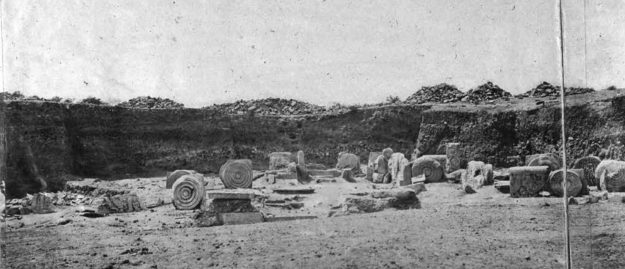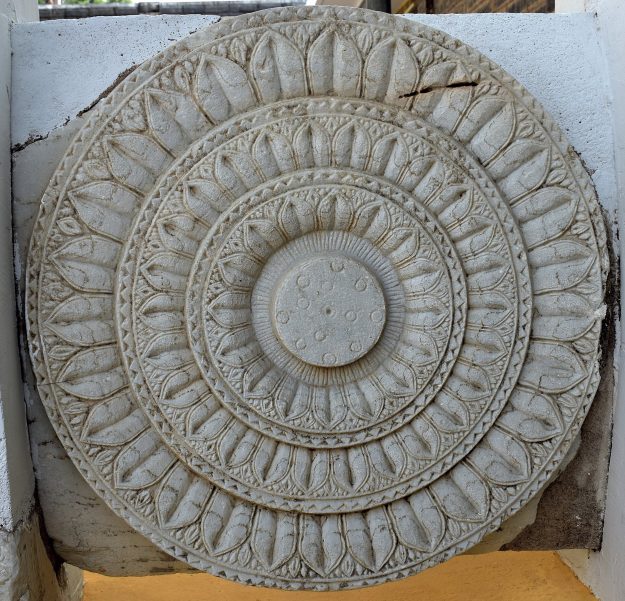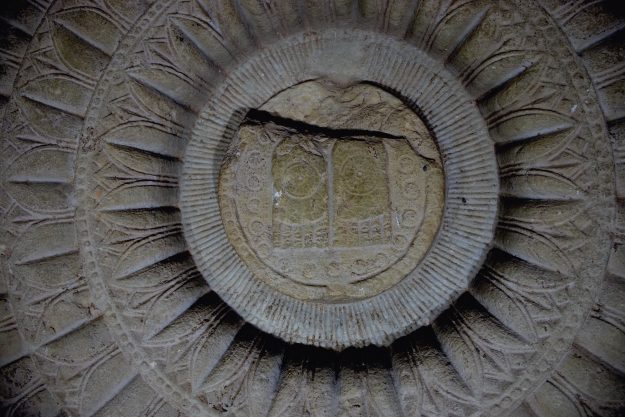Origin of Origins
A new look at Amaravati, an important Buddhist monument that hints at the dawn of the Mahayana The post Origin of Origins appeared first on Tricycle: The Buddhist Review.

Sometime in the 2nd century BCE, in the Krishna River delta region of modern-day Andhra Pradesh, a Buddhist monument arose that would become one of the most stunning sites in India. The Amaravati stupa, by the late 3rd century CE, stood over sixty feet tall and extended more than a hundred feet in diameter. Richly adorned with intricately carved narrative panels, symbolic motifs, and sculptures, it embodied both religious devotion and artistic ingenuity. Yet, despite its grandeur, Amaravati today lies in ruins, fragmented and dispersed across museums worldwide, challenging us to piece together its former wonder.
In his latest work, Amāravatī: Art and Buddhism in Ancient India, Jaś Elsner, professor of Late Antique Art at the University of Oxford, addresses precisely this challenge. Renowned for his nuanced analysis of visual culture and religion, Elsner brings unparalleled scholarly depth to reconstituting the meaning of Amaravati’s images and spaces.
Amaravati was the first Buddhist stupa to be “discovered” by British colonials in India, which explains why so little is known of the original contexts of its sculptures. Excavations conducted between the late 18th and late 19th centuries were carried out haphazardly and with little concern for proper archaeological documentation. Today, approximately 500 reliefs, sculptures, and architectural fragments, in various states of preservation, survive from Amaravati and are housed in different collections, primarily the British Museum, Chennai Government Museum, and Amaravati Archaeological Museum. The site has yielded more than 300 inscriptions, but these provide limited information regarding historical particulars or the identification of sculptural subjects. No religious text survives that can be explicitly linked to the period or place of the stupa’s construction.
Elsner is nevertheless able to reference a great deal of later Buddhist and Indic literature in his reexamination of Amaravati’s visual and inscriptional evidence. His analysis hinges mainly on his recognition of Amaravati as “an origin of origins,” as related in later strata of Buddhist texts that linked the site with the birthplace of Sumedha, whom the past Buddha Dipankara predicted would become Gautama Buddha, the historical Buddha of our time. Upon encountering Dipankara, according to the literature, Sumedha made a bodhisattva vow to help all beings to enlightenment. This connection is not mentioned in previous studies of Amaravati, though it provides a critical contextual framework for understanding the site.
 Excavation of the south gate of the stupa by J. G. Horsfall in 1880. Image via Wikimedia Commons.
Excavation of the south gate of the stupa by J. G. Horsfall in 1880. Image via Wikimedia Commons.The origin story links Amaravati with the earliest formulations—in image rather than text—of concepts that would be central to later Mahayana Buddhism in India. Though Mahayana Buddhism cannot be discussed with great certainty before the 5th century, some of its thought can be linked with Buddhist lineages active in the Amaravati region during the early centuries CE. Many esteemed Mahayana teachers hailed from Andhra, and several notable scriptures, including the Gandavyuha Sutra, may have originated from this region. Sudhana, the hero of that text, is even said to have taken the bodhisattva vow at Amaravati.
Elsner’s concern throughout the book is not to explicitly link the image with the textual source but to consider the ways in which Amaravati’s rich visual culture gave expression to, and perhaps even anticipated or shaped to some degree, the complex Buddhist thinking that evolved alongside it. Among the intellectual developments with which he is concerned are elucidations of Buddhist perfections, formulations of the bodhisattva path, and early conceptualizations of multiple buddhas and buddha bodies. Through close analysis of various image types and narratives, read within a context of contemporary intellectual ferment and creativity, and guided by an imagined movement through architectural space, Elsner provides several new perspectives, even on what might appear to be the most standardized of Buddhist imagery.
Richly adorned with intricately carved narrative panels, symbolic motifs, and sculptures, the Amaravati stupa embodied both religious devotion and artistic ingenuity.
This imagery includes the lotus medallions that so prominently adorn the Amaravati railing and appear in miniature on the stupa’s many reliefs. Early in the book, Elsner draws attention to their great variety, as no lotus medallions appear the same. He also notes their visual doubling; lotuses appear from different angles and in various forms—such as a bud, a partially open flower, or a garland—across the monument. The stupa is where the living presence of the Buddha, said to be like a lotus himself, was established by his interred relics. An approaching worshipper would have perceived the stupa’s form rising above the railing, a conceptual parallel to sculptural imagery showing the Buddha seated or standing upon a lotus. It is also possible, as Elsner suggests, that the many lotuses refer to Sumedha’s taking of the bodhisattva vow, for he is said to have offered such flowers to Dipankara; these miraculously transformed into a stupa crowning the past Buddha’s head. The numerous flower garlands adorning the stupa also highlight appropriate forms of Buddhist veneration, writ large across the railing and exemplified in many figural scenes.
 Well-preserved lotus crossbar with surviving tenons, central seedpods, and three rows of petals from the reconstruction of a segment of railing in the Amaravati site museum. Image via Jaś Elsner.
Well-preserved lotus crossbar with surviving tenons, central seedpods, and three rows of petals from the reconstruction of a segment of railing in the Amaravati site museum. Image via Jaś Elsner.Elsner also considers the connection between floral garlands and the metaphorical use of the term mala (garland) in literature to reference collections of stories. The numerous narrative medallions at Amaravati, framed by lotus petals, appear to have been conceived as an offering themselves, as a celebration of the Buddha’s past lives and the bodhisattva path as a model. Toward the end of the book, Elsner notes the emphasis on circular forms at Amaravati and the interplay between the massive three-dimensional presence of the stupa and the two-dimensional shapes of the lotus, dharmacakra (the eight-spoked wheel that symbolizes the Buddha’s teaching), narrative roundel, and other visual devices. It is as if Amaravati’s makers intended to highlight the problem of partial perspectives and the difficulty of grasping totality, while extending to devotees the possibility of transcending wrong views through an embrace of the monument’s teachings.
While previous art-historical scholarship has situated Buddhist teachings within visual narratives, Elsner brings a variety of non-narrative imagery into his explication of Amaravati’s instantiation of Buddhist doctrines. The above-mentioned interplay between two- and three-dimensional forms, for instance, applies to the many relief images of stupas that appear in worship scenes and narrative panels, as well as in the large-scale replicas of Amaravati itself in the drum reliefs, all of which reflect upon the physical stupa at the heart of the site. One also finds an interplay between Buddha images and the Buddha’s living presence at the site, due to the presence of his relics. Elsner’s masterful analysis of images of footprints (buddhapadas) compares their narrative representation as foci of worship and symbols of the Buddha’s absence with freestanding relief panels in which the footprints express the Buddha’s supramundane presence through an inventive non-naturalism.
 Buddhapada slab surrounded by a low-relief lotus frame. Image via Jaś Elsner.
Buddhapada slab surrounded by a low-relief lotus frame. Image via Jaś Elsner.This multiplicity of forms engages with Buddhist notions of illusion, which were highly developed in texts such as the Gandavyuha Sutra. Elsner also investigates how artistic multiplicity establishes a pattern of interpenetration and reflectivity—between the physical stupa and representational ones, between Amaravati and its relief duplicates, between macrocosm and microcosm—that correlates with the vision of an enlightened being as described in the Gandavyuha Sutra.
The visual narratives at Amaravati, primarily drawn from the Buddha’s past lives and biography, may also be viewed from a perspective that admits parallel and intersecting developments between visual art and doctrine. They adorn most architectural surfaces and can be read even within the replica stupas presented on the drum reliefs. Many scenes are arranged in a manner that implies causative and karmic links between the Buddha’s past actions and his historical life. They highlight, in fact, the perfections he cultivated over many lifetimes. Several narrative reliefs are indeterminate about place and time because the Buddha’s representation takes an aniconic, or symbolic, form. This is especially true for images recalling significant events, such as the first sermon or enlightenment, which are indicated across the monument by, respectively, the dharmacakra and empty seat beneath a Bodhi tree. These images do not just suggest the Buddha’s physical absence. Instead, their suspension of narrative time implies a cosmic framework for the Buddha’s achievements and thus, as Elsner notes, the possibility of future buddhahood for those emulating his model.
The book’s dense exploration is occasionally demanding, requiring readers to closely follow complex connections between visual and textual sources. Nonetheless, Elsner’s detailed readings consistently reward sustained attention.
Elsner has made a vital contribution to art history by proposing innovative ways of understanding an early Buddhist site like Amaravati. His approach consistently highlights the extraordinary and inventive uses of repetition and reflection that constituted complex layers of meaning, inviting readers to consider how visual culture shapes religious thought and practice. In reconstituting this fragmented site, Elsner’s analysis implicitly asks contemporary readers: How do the monuments we encounter—both ancient and modern—reflect, challenge, or enrich our understanding and practice of Buddhism?

 UsenB
UsenB 



















![The 2026 AI Search Benchmark Every SEO Leader Needs [Webinar] via @sejournal, @lorenbaker](https://www.searchenginejournal.com/wp-content/uploads/2025/11/1-259.png)











(1).jpeg)